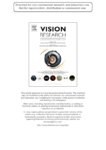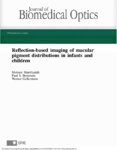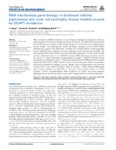|
|
Creator | Title | Description | Subject | Date |
| 126 |
 |
Baehr, Wolfgang | Pharmacological and rAAV gene therapy rescue of visual functions in a blind mouse model of Leber congenital amaurosis | BACKGROUND: Leber congenital amaurosis (LCA), a heterogeneous early-onset retinal dystrophy, accounts for approximately 15% of inherited congenital blindness. One cause of LCA is loss of the enzyme lecithin:retinol acyl transferase (LRAT), which is required for regeneration of the visual photopigmen... | Disease Models, Animal; Genetic Vectors; Molecular Sequence Data | 2005 |
| 127 |
 |
Baehr, Wolfgang | Phenolic components from the leaves of the Ginkgo tree (Ginkgo biloba L) | No summary- Article is in German. | Flavonoids; Chromatography; Phenols; Plant Extracts; Ginkgo Biloba L. | 1968-05 |
| 128 |
 |
Digre, Kathleen B.; Couldwell, William T.; Amini, Amin | Photophobia in a blind patient: An alternate visual pathway. Case report. | Photophobia is a common neurological and ophthalmological symptom that has been associated with a growing number of neurosurgical conditions, especially compressive lesions. The exact signaling pathways and neurophysiological features of the disorder are not well understood; however, data from multi... | Photophobia, Blindness, Signaling Pathway, Pretectal Nuclei, Trigeminal Pathway | 2006-12-14 |
| 129 |
 |
Baehr, Wolfgang; Prestwich, Glenn D. | Photoreceptor cGMP phosphodiesterase delta subunit (PDEdelta) functions as a prenyl-binding protein | Bovine PDEdelta was originally copurified with rod cGMP phosphodiesterase (PDE) and shown to interact with prenylated, carboxymethylated C-terminal Cys residues. Other studies showed that PDEdelta can interact with several small GTPases including Rab13, Ras, Rap, and Rho6, all of which are prenylate... | Fluorescence Resonance Energy Transfer; GTP Phosphohydrolases; Immunohistochemistry | 2004 |
| 130 |
 |
Olson, Randall J.; Mamalis, Nick; Spencer, Terrence S. | Postoperative sterile endophthalmitis (TASS) associated with the memorylens | PURPOSE: To report 10 cases of delayed-onset acute intraocular inflammation following cataract extraction and posterior chamber implantation of the MemoryLens(R) intraocular lens (IOL). SETTING: John A. Moran Eye Center, Department of Ophthalmology, University of Utah, Salt Lake City, Utah, USA. MET... | Memory Lens; Toxic Anterior Segment Syndrome; Retrospective Studies; adverse effects | 2000-12 |
| 131 |
 |
Frederick, Jeanne M. | The prenyl-binding protein PrBP/δ: A chaperone participating in intracellular trafficking | Expressed ubiquitously, PrBP/d functions as chaperone/co-factor in the transport of a subset of prenylated proteins. PrBP/d features an immunoglobulin-like b-sandwich fold for lipid binding, and interacts with diverse partners. PrBP/d binds both C-terminal C15 and C20 prenyl side chains of phototran... | | 2012-01-01 |
| 132 |
 |
Baehr, Wolfgang | Primary structure and chromosomal localization of human and mouse rod photoreceptor cGMP-gated cation channel | We have determined the primary structures of the human and mouse retinal rod cGMP-gated cation channel by analysis of cDNA clones and amplified DNA. The open reading frames predicted polypeptides of 690 and 683 residues exhibiting 88% sequence similarity. Sequence comparison indicated that the rod c... | Restriction Mapping; Sequence Homology, Nucleic Acid; Chromosomes, Human, Pair 4 | 1992 |
| 133 |
 |
Varner, Michael W.; Digre, Kathleen B. | Pseudotumor cerebri and pregnancy. | Pseudotumor cerebri (PTC) is most commonly seen in obese women of reproductive age. We studied 109 women with PTC between ages 16 and 44 years. In 11, PTC started during pregnancy. Thirteen women with previous diagnosis of PTC, including two of the aforementioned 11, had an additional 17 documented ... | Pregnancy Complications; Pseudotumor Cerebri; Vision disorders; Headache; Intracranial Pressure | 1984-06 |
| 134 |
 |
Bernstein, Paul S.; Gellermann, Werner | Raman detection of macular carotenoid pigments in intact human retina | PURPOSE: To develop and test a novel noninvasive optical technique suitable for the objective measurement of macular carotenoid levels in human retina. METHODS: A resonance Raman scattering apparatus was constructed to measure carotenoid levels in flat-mounted human retinas and eyecups and in experi... | Rana pipiens; Spectrum Analysis, Raman; Xanthophylls | 1998 |
| 135 |
 |
Frederick, Jeanne M.; Baehr, Wolfgang | Receptor for advanced glycation end products and age-related macular degeneration. | Advanced glycation end products (AGE) exacerbate disease progression through two general mechanisms: modifying molecules and forming nondegradable aggregates, thus impairing normal cellular/tissue functions, and altering cellular function directly through receptor-mediated activation. In the present... | Optic Atrophies, Hereditary; Apoptosis; Pigment Epithelium of Eye | 2004 |
| 136 |
 |
Baehr, Wolfgang | Receptors for advanced glycation end products as progressive factors in age-related macular degeneration | Advanced glycation end products (AGE) exacerbate disease progression through two general mechanisms: modifying molecules and forming nondegradable aggregates, thus impairing normal cellular/tissue functions, and altering cellular function directly through receptor-mediated activation. In the prese... | Advanced glycation end products; AGE; receptor for AGE-mediated cellular activation; RAGE | 2004 |
| 137 |
 |
Bernstein, Paul S. | Reflection-based imaging of macular pigment distributions in infants and children | We have developed a reflection-based capability of the RetCam® platform, an FDA-cleared pediatric retinal-imaging instrument, for the purpose of measuring macular pigment levels as well as their spatial distributions in infants and children. Our modifications include narrow-band blue-wavelength exc... | | 2013-01-01 |
| 138 |
 |
Creel, Donnell J.; Leventhal, Audie G. | Retinal projections in tyrosinase-negative albino cats | Retinal projections were examined in two tyrosinase-negative albino cats using autoradiographic techniques. Cats from this colony have pink eyes; their retinal pigment epithelium, ciliary body, and iris epithelium are completely devoid of melanin pigment. Test breeding for five generations indicates... | Cats; Albinism; Vision; Autoradiography; Retina | 1982-07 |
| 139 |
 |
Bernstein, Paul S. | Retinal tubulin binds macular carotenoids | PURPOSE: To investigate the biochemical mechanisms responsible for the specific uptake, concentration, and stabilization of the carotenoids lutein and zeaxanthin in the macula. METHODS: Soluble extracts of bovine retina mixed with radioactive carotenoids were purified by hydrophobic interaction, ion... | Chromatography, Gel; Electrophoresis; Xanthophylls | 1997 |
| 140 |
 |
Baehr, Wolfgang | Retinoid absorption and storage is impaired in mice lacking lecithin:retinol acyltransferase (LRAT) | Lecithin:retinol acyltransferase (LRAT) is believed to be the predominant if not the sole enzyme in the body responsible for the physiologic esterification of retinol. We have studied Lrat-deficient (Lrat-/-) mice to gain a better understanding of how these mice take up and store dietary retinoids a... | Chromatography, High Pressure Liquid; Mice, Transgenic; Tissue Distribution | 2005 |
| 141 |
 |
Frederick, Jeanne M. | RNA interference gene therapy in dominant retinitis pigmentosa and cone-rod dystrophy mouse models caused by GCAP1 mutations | RNA interference (RNAi) knockdown is an efficacious therapeutic strategy for silencing genes causative for dominant retinal dystrophies. To test this, we used self-complementry (sc) AAV2/8 vector to develop an RNAi-based therapy in two dominant retinal degeneration mouse models. The allele-specific ... | | 2014-01-01 |
| 142 |
 |
Kriesel, John D.; Spruance, Spotswood L. | Rocky Mountain spotted fever following cardiac transplantation. | ROCKY MOUNTAIN SPOTTED FEVER was first recognized in the early 1 900s in the Snake River Valley of Idaho and the Bitterroot Valley of western Montana.t In 1909, Howard Taylor Ricketts established the ixodid tick as the vector for the disease.2 Following the tick bite, the incubation period aver... | Male; Adult; Humans | 1993 |
| 143 |
 |
Angelucci, Alessandra | Role for nitric oxide in the development of the ferret retinogeniculate projection | The ferret retinogeniculate projection segregates into eye-specific layers during the first postnatal week and into ON/OFF sublaminae, which receive inputs from either on-center or off-center retinal ganglion cells, during the third and fourth postnatal weeks. The restriction of retinogeniculate axo... | Enzyme Inhibitors; Visual Pathways; Wheat Germ Agglutinin-Horseradish Peroxidase Conjugate | 1996 |
| 144 |
 |
Baehr, Wolfgang | Role of photoreceptor-specific retinol dehyrogenase (prRDH) in the retinoid cycle in vivo | The retinoid cycle is a recycling system that replenishes the 11-cis-retinal chromophore of rhodopsin and cone pigments. Photoreceptor-specific retinol dehydrogenase (prRDH) catalyzes reduction of all-trans-retinal to all-trans-retinol and is thought to be a key enzyme in the retinoid cycle. We d... | Rhodopsin, Photoreceptors; prRDH (RDH8); All-trans-RDH; A2E; Retinoid cycle; Dark adaptation | 2005 |
| 145 |
 |
Olson, Randall J.; Coldwell, Karin D.; Compton, Bruce J.; Giddings, John C. | Sedimentation field-flow fractionation: a method for studying particulates in cataractous lens | It is shown that the technique of sedimentation field-flow fractionation (sedimentation [sed] FFF) can be used to determine the particle content and particle size distribution of normal and cataractous lenses. A 31-year-old normal human lens, for example, showed a particle content of 1.5% by weight ... | Fractionation; Cataractous Lens; Particulates | 1984 |
| 146 |
 |
Angelucci, Alessandra | Segregation and overlap of callosal and association neurons in frontal and parietal cortices of primates: a spectral and coherency analysis. | The spatial relations between selected classes of association and callosal neurons were studied in the frontal and parietal lobes of the macaque monkey using retrogradely transported fluorescent dyes. Fast blue and nuclear yellow were injected in the left frontal (areas 4 and 6) and right posterior ... | Macaca fascicularis; Parietal Lobe; Neurons | 1989 |
| 147 |
 |
Normann, Richard A.; Clark, Gregory A.; McDonnall, Daniel | Selective motor unit recruitment via intrafascicular multielectrode stimulation | Recruitment of force via independent asynchronous firing of large numbers of motor units produces the grace and endurance of physiological motion. We have investigated the possibility of reproducing this physiological recruitment strategy by determining the selectivity of access to large numbers of ... | Funtional Neuromuscular Stimulation; Microelectrode Array; Neuroprosthesis; Intrafascicular Multielectrode Stimulation; Cats | 2004 |
| 148 |
 |
Digre, Kathleen B. | Selective MR imaging approach for evaluation of patients with Horner's syndrome. | PURPOSE: To assess the usefulness of MR in the evaluation of patients with Horner's syndrome. PATIENTS AND METHODS: We prospectively performed MR imaging in 33 patients with Horner's syndrome (13 preganglionic and 20 postganglionic) using a protocol specifically designed for pre- and postganglionic ... | Horner Syndrome; Magnetic Resonance Imaging; Epidemiology | 1992-01 |
| 149 |
 |
Bernstein, Paul S. | Senior-Løken syndrome: a syndromic form of retinal dystrophy associated with nephronophthisis | Senior-Løken syndrome (SLS) is an autosomal recessive disease characterized by development of a retinitis (RP)- or Leber congenital amaurosis (LCA)-like retinal dystrophy and a medullary cystic kidney disease, nephronophthisis. Mutations in several genes (called nephrocystins) have been shown to ca... | | 2012-01-01 |
| 150 |
 |
Askew, Eldon W.; Bernstein, Paul S. | Serum and macular responses to antioxidant supplementation verus a carotenoid-rich dietary intervention in the elderly. | The aim of this study was to observe responses of serum antioxidants, oxidative stress biomarkers, and macular carotenoid pigments to antioxidant supplements or dietary intervention in a single-masked, randomized, pilot clinical study of elderly subjects receiving antioxidant supplements or a dietar... | Macula; Serum Carotenoids; Zeaxanthin | 2006-02-01 |

























